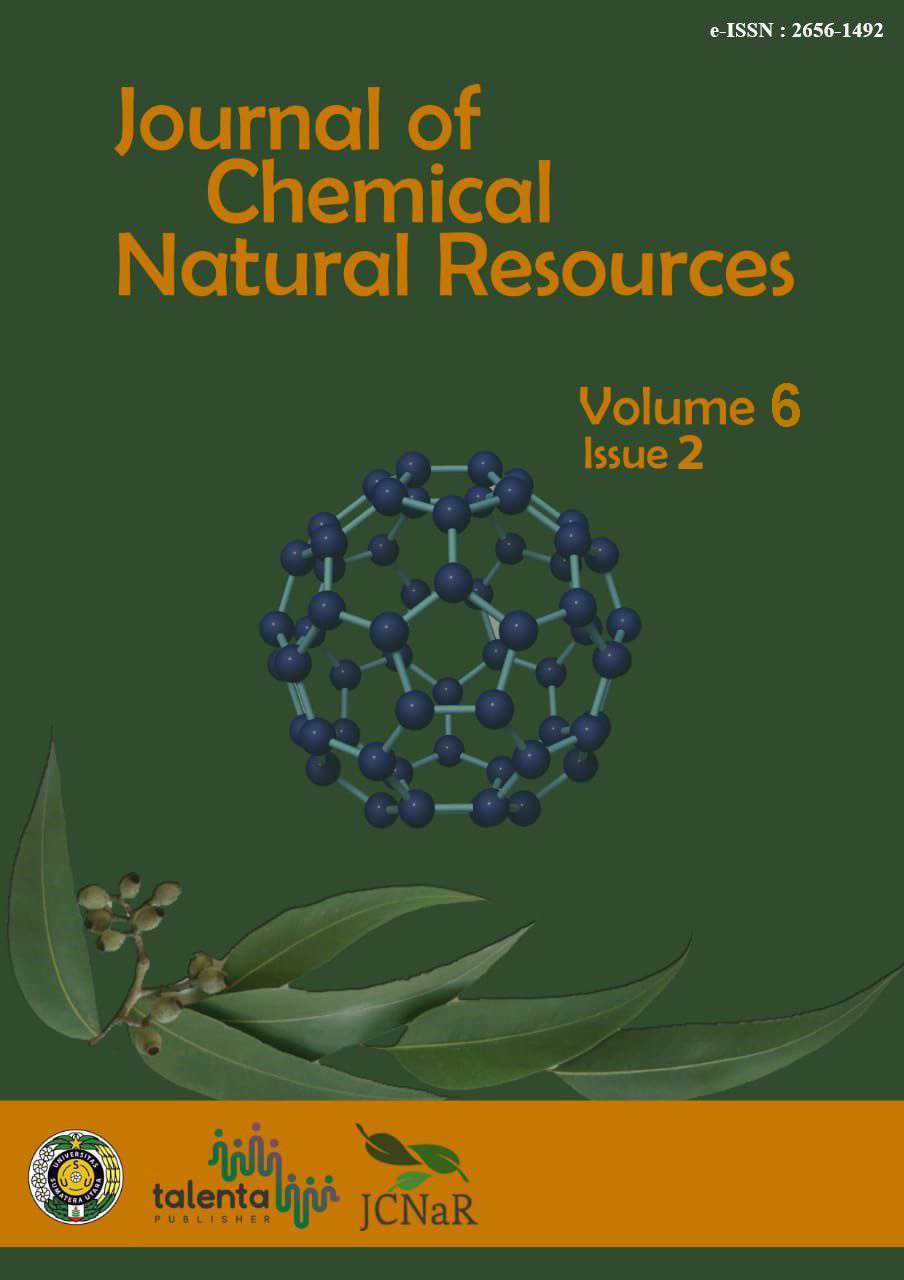Isolation of Flavonoid Compound from Kareumbi Fruit (Homalanthus populneus (Geiseler) Pax)
DOI:
https://doi.org/10.32734/jcnar.v6i2.18120Keywords:
Flavonoid, Flavonol, Homalanthus populneus (Geiseler) Pax, KareumbiAbstract
Flavonoid compounds were isolated from Kareumbi fruit (Homalanthus populneus) using a sequential extraction and purification process. Methanol-concentrated extract was partitioned with ethyl acetate and n-hexane. The concentrated methanol extract was separated by column chromatography using a gradient elution of chloroform and methanol, varying the ratio 90:10; 80:20; 70:30; and 60:40 (v/v). Subsequent column chromatography yielded a yellowish-orange paste (19.6 mg, Rf = 0.73) from the chloroform:methanol (70:30) fraction. UV-visible, FT-IR, and 1H-NMR spectroscopic analysis confirmed that the isolated compounds belonged to the flavonol class of flavonoids.
Downloads
References
H. Doloking, N. Tahar, Mukhriani, and Surya Ningsi, “Flavonoids: A Review On Extraction, Identification, Quantification, and Antioxidant Activity,†Ad-Dawaa’ J. Pharm. Sci., vol. 5, no. 1, 2022, doi: 10.24252/djps.v5i1.29329.
G. Agati et al., “Are flavonoids effective antioxidants in plants? Twenty years of our investigation,†Antioxidants, vol. 9, no. 11, pp. 1–17, 2020, doi: 10.3390/antiox9111098.
E. Sintya, N. Wijayanti, and A. Noraeni, “The effect of Homalanthus populneus (Giesel.) pax. extract in expression of T-cell receptor: Inhibition study of HIV infection,†Int. J. Appl. Pharm., vol. 11, no. Special Issue 5, pp. 134–137, 2019, doi: 10.22159/ijap.2019.v11s5.T0106.
P. N. T. Tran and T. T. N. Tran, “Evaluation of Acute and Subchronic Toxicity Induced by the Crude Ethanol Extract of Plukenetia volubilis Linneo Leaves in Swiss Albino Mice,†Biomed Res. Int., vol. 2021, 2021, doi: 10.1155/2021/6524658.
N. Kartika, “Aktivitas Antivirus Ekstrak Etanolik Batang Tutup Abang (Homalanthus Populneus ( Giesel .) Pax ) Terhadap Virus Avian Influenza H5n1 Antiviral Activity of Ethanolic Extract Of Tutup Abang Stem ( Homalanthus populneus ( Giesel .) Pax ) Against H5N1 Avian,†Gadjah Mada, 2015.
T. Rudiana, S. Nurbayti, T. H. Ashari, S. A. Zhorif, and N. Suryani, “Comparison of Maceration and Soxhletation Methods on the Antioxidant Activity of the Bouea macrophylla Griff Plant.,†J. Kim. Val., vol. 9, no. 2, pp. 244–252, 2023, doi: 10.15408/jkv.v9i2.35239.
H. Sihombing, S. Lenny, and L. Marpaung, “Isolation of Flavonoids Compounds from Kesumba,†J. Chem. Nat. Resour., vol. 04, no. 02, pp. 96–104, 2022.
M. Heneczkowski, M. Kopacz, D. Nowak, and A. Kuźniar, “Infrared spectrum analysis of some flavonoids,†Acta Pol. Pharm. - Drug Res., vol. 58, no. 6, pp. 415–420, 2001.
L. S. Aisyah et al., “Flavonoid compounds from the leaves of Kalanchoe prolifera and their cytotoxic activity against P-388 murine leukimia cells,†Nat. Prod. Sci., vol. 23, no. 2, pp. 139–145, 2017, doi: 10.20307/nps.2017.23.2.139.

Downloads
Published
Issue
Section
License
Copyright (c) 2024 Journal of Chemical Natural Resources

This work is licensed under a Creative Commons Attribution-ShareAlike 4.0 International License.














